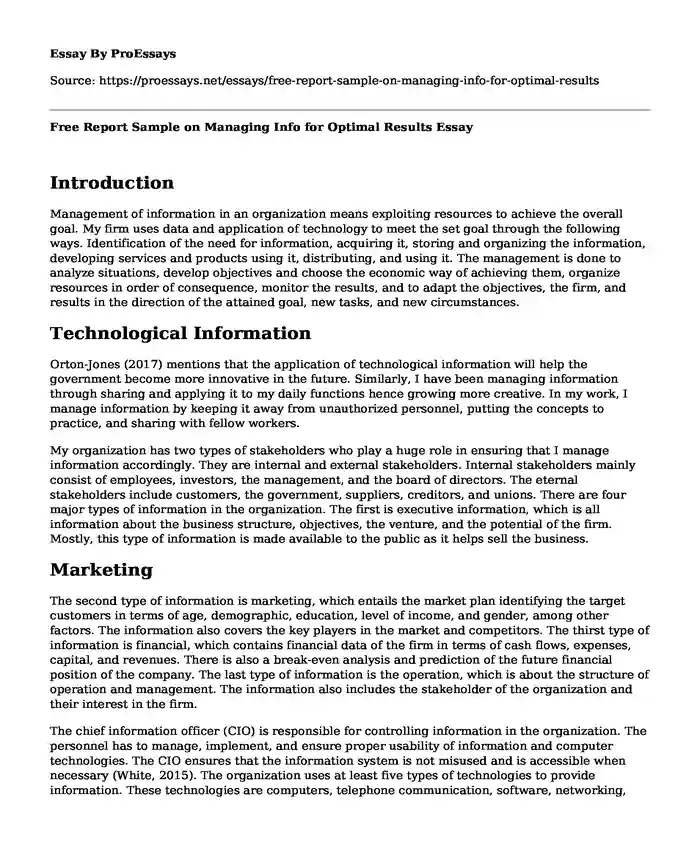Introduction
Management of information in an organization means exploiting resources to achieve the overall goal. My firm uses data and application of technology to meet the set goal through the following ways. Identification of the need for information, acquiring it, storing and organizing the information, developing services and products using it, distributing, and using it. The management is done to analyze situations, develop objectives and choose the economic way of achieving them, organize resources in order of consequence, monitor the results, and to adapt the objectives, the firm, and results in the direction of the attained goal, new tasks, and new circumstances.
Technological Information
Orton-Jones (2017) mentions that the application of technological information will help the government become more innovative in the future. Similarly, I have been managing information through sharing and applying it to my daily functions hence growing more creative. In my work, I manage information by keeping it away from unauthorized personnel, putting the concepts to practice, and sharing with fellow workers.
My organization has two types of stakeholders who play a huge role in ensuring that I manage information accordingly. They are internal and external stakeholders. Internal stakeholders mainly consist of employees, investors, the management, and the board of directors. The eternal stakeholders include customers, the government, suppliers, creditors, and unions. There are four major types of information in the organization. The first is executive information, which is all information about the business structure, objectives, the venture, and the potential of the firm. Mostly, this type of information is made available to the public as it helps sell the business.
Marketing
The second type of information is marketing, which entails the market plan identifying the target customers in terms of age, demographic, education, level of income, and gender, among other factors. The information also covers the key players in the market and competitors. The thirst type of information is financial, which contains financial data of the firm in terms of cash flows, expenses, capital, and revenues. There is also a break-even analysis and prediction of the future financial position of the company. The last type of information is the operation, which is about the structure of operation and management. The information also includes the stakeholder of the organization and their interest in the firm.
The chief information officer (CIO) is responsible for controlling information in the organization. The personnel has to manage, implement, and ensure proper usability of information and computer technologies. The CIO ensures that the information system is not misused and is accessible when necessary (White, 2015). The organization uses at least five types of technologies to provide information. These technologies are computers, telephone communication, software, networking, accounting system, and inventory control system. The technological data obtained in the organization helps the firm to run effectively. The major uses of the data are to identify areas of investment, monitor the profitability of the firm, maximize the return investment of the organization, and show areas that need improvement. Using technological data in the organization is very helpful because the firms make more profits and innovation.
Technological data makes a huge difference in organizational policies. The information sheds light on workplace behavior, general human resource functioning, and even other firm operations. Policies exist to guide the employees, whereby they are rules and regulations that need to be followed for healthy relationships. More information helps the employees understand the need to embrace the policies and change them when needed. Also, with enough information, employees grow more motivated and productive. Knowledge and resources are very useful aspects that positively influence the performance of the workers. Increased performance means improved results.
My organization is information-centric. Indeed, it has a culture of relying on data that is analyzed, stored, and visualized for use. The culture forms an integral segment of decision making. By sending data to a large group, the information users make the best decisions regarding daily operations. ICT strategic framework will help me maximize information management and information technology at the workplace. The framework aim at the key elements that are needed when considering the management of information resources in organizations. According to Foreshew-Cain (2016), the government will need to use an ICT strategic framework to manage information resources well if achieving the 2030 information goal. ICT strategic framework represents components and relationships which may be considered ideal in the future technological environment. Furthermore, its applicability is obvious depending on the complexity and size of the organization.
Conclusion
Our organization, just like many governments, values the use of acquired information. Many organizations that have put the management of information and technology resources upfront have succeeded. Besides, today's changing world caused by advancements in technology requires organizations to be well informed. If the organization has the benefit of using ICT strategic framework, it more likely to produce an innovative information technology team than an organization that does not use it. Hence, other than maximizing information management and IT, it is important for innovation.
References
Foreshew-cain, S. (2016, May 11). What Government Might Look Like in 2030 - Government Digital Service. https://gds.blog.gov.uk/2016/05/11/what-government-might-look-like-in-2030/
Orton-Jones, C. (2017, October 25). The Future of Government is Digital. Raconteur. https://www.raconteur.net/technology/public-sector-technology-2017/the-future-of-government-is-digital
White, J. D. (2015). Managing Information in the Public Sector. In Google Books. Routledge. https://books.google.co.ke/books?hl=en&lr=&id=HWymBgAAQBAJ&oi=fnd&pg=PP1&dq=managing+information+in+the+public+sector+jay+white+&ots=nssfAckw2-&sig=4QXzK1sozZfKNIUT4RwdNM8Ko5I&redir_esc=y#v=onepage&q=managing%20information%20in%20the%20public%20sector%20jay%20white&f=false.
Cite this page
Free Report Sample on Managing Info for Optimal Results. (2023, Nov 16). Retrieved from https://proessays.net/essays/free-report-sample-on-managing-info-for-optimal-results
If you are the original author of this essay and no longer wish to have it published on the ProEssays website, please click below to request its removal:
- Essay on Elections in the UK
- Opium Wars and the British East India Company Essay
- The Universal Design for Learning Approach Paper Example
- Transformational Leadership & Job Design Impact on Employee Wellness & Performance - Essay Sample
- Paper Example on Good Governance and Democratic Legitimacy: Definition and Application
- Advertising: Key to Connecting Consumers to Products and Services - Essay Sample
- Essay Sample on Sustaining Patient-Centered Medical Homes: Strategies, Innovations, and Policy Impacts







